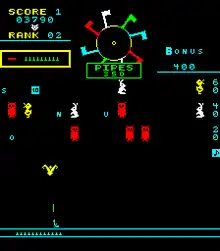| Carnival | |
|---|---|
_cover.jpg.webp) | |
| Developer(s) | Gremlin |
| Publisher(s) | Arcade Ports Coleco (ColecoVision, 2600, Intellivision) ANALOG Software (Atari 8-bit) |
| Designer(s) | Lane Hauck[3] |
| Programmer(s) | Atari 2600 Dan Kitchen[4] Atari 8-bit Phil Mork[4] |
| Platform(s) | Arcade, Atari 2600, Atari 8-bit, ColecoVision, Intellivision |
| Release | Arcade Ports 1982 |
| Genre(s) | Fixed shooter |
| Mode(s) | 1-2 players alternating |
| Arcade system | Dual |
Carnival is a fixed shooter developed by Gremlin and released by Sega in arcades in 1980.[5] It was one of the first video games with a bonus round.[6]
Carnival was ported to the Atari 2600, ColecoVision, and Intellivision by Coleco. A licensed Atari 8-bit family version was published in 1982 by ANALOG Software, the commercial software label of ANALOG Computing magazine.[7][8] In 1983, Acornsoft published Carnival for the BBC Micro.
Gameplay

The goal of the game is to shoot at targets while conserving a limited ammunition supply for as long as possible. There are buttons for firing and left/right movement. The cocktail version replaces the directional buttons with a two-way joystick.
Three rows of targets scroll across the screen in alternating directions; these include rabbits, ducks, owls, and extra-bullet targets, with higher rows awarding more points. If a duck reaches the bottom row without being shot, it will come to life and begin flying down toward the player. Any ducks that reach the bottom of the screen in this manner will eat some of the player's bullets. New ducks are added to the top row at intervals. A large pop-up target above the top row can either award or subtract bullets or points when hit. A spinning wheel with eight pipes also sits above the top row; the point value of the pipes decreases for every shot that does not hit one of them. In addition, a bonus counter increases by the value of every target shot in the three rows, and can be collected by shooting the letters of the word "BONUS" in order as they cycle through the rows. The bonus stops increasing as soon as any letter is shot.
A round ends when all targets and pipes have been shot. The player receives bonus points for all unused bullets, then plays a bonus round in which a large bear with a target walks across the screen. Each time the bear is shot, it rears up for a second, then begins walking more quickly in the other direction. The object is to shoot the bear as many times as possible until it escapes off the screen, using unlimited ammunition. Following the bonus round, the next wave begins. Each subsequent bonus round adds a bear to the screen, to a maximum of four.
Higher levels feature increased target point values, more ducks, fewer extra-bullet targets, faster-moving targets, and an increased rate at which new ducks appear. The game ends when the player's ammunition supply is exhausted through firing and/or being eaten by ducks.
Development
Carnival is one of the few games that has two different PCBs, one for each version; normally a game only has one PCB with a DIP switch that sets it to either upright or cocktail mode. The upright and cocktail cabinets each come in two varieties, one woodgrain and the other painted orange and white.
The tune that plays throughout the game is "Sobre las Olas" (Over the Waves) by Juventino Rosas, a tune commonly associated with carnivals and funfairs. The game's General Instrument AY-3-8910 chip allows for a relatively complex rendition of Rosas's waltz with overlaid sound effects.
Reception
Electronic Games called the ColecoVision port of Carnival "a letter-perfect recreation of the arcade original that's not to be missed."[9]
In a retrospective discussion of the arcade game's music, video game scholar Andrew wrote, "as the track makes use of all three tone-channels—using two for the waltz's characteristic oom-pah-pah and one for its memorable melody—the resulting texture is rich enough to do the music justice. And the inclusion of numerous sound effects, including three different duck quacks and a bear's roar, makes for a veritable sonic feast."[10]
References
- 1 2 "1979". Sega Arcade History. Famitsu DC (in Japanese). Enterbrain. 2002. pp. 37–39 (38).
- 1 2 Akagi, Masumi (13 October 2006). アーケードTVゲームリスト国内•海外編(1971-2005) [Arcade TV Game List: Domestic • Overseas Edition (1971-2005)] (in Japanese). Japan: Amusement News Agency. p. 131. ISBN 978-4990251215.
- ↑ "San Diego's Gremlin: how video games work". San Diego Reader. 1982-07-15. Retrieved 2020-10-25.
- 1 2 Hague, James. "The Giant List of Classic Game Programmers".
- ↑ "Carnival". The International Arcade Museum. Retrieved 9 Nov 2013.
- ↑ June, Laura (December 8, 2012). "The Classics: 'Carnival'". The Verge. Vox Media. Archived from the original on August 23, 2016. Retrieved March 23, 2021.
- ↑ Pappas, Lee (May 12, 2014). "ANALOG Software". GearRant. Archived from the original on December 8, 2015. Retrieved January 3, 2016.
- ↑ "Carnival". Atari Mania.
- ↑ Katz, Arnie; Kunkel, Bill (May 1983). "Programmable Parade: Carnival". Electronic Games. 1 (15): 36–37.
- ↑ Schartmann, Andrew. Maestro Mario: How Nintendo Transformed Videogame Music into an Art. New York: Thought Catalog, 2013.